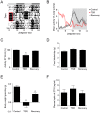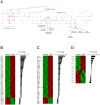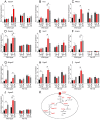Circadian clock genes Per1 and Per2 regulate the response of metabolism-associated transcripts to sleep disruption
- PMID: 23285241
- PMCID: PMC3532432
- DOI: 10.1371/journal.pone.0052983
Circadian clock genes Per1 and Per2 regulate the response of metabolism-associated transcripts to sleep disruption
Abstract
Human and animal studies demonstrate that short sleep or poor sleep quality, e.g. in night shift workers, promote the development of obesity and diabetes. Effects of sleep disruption on glucose homeostasis and liver physiology are well documented. However, changes in adipokine levels after sleep disruption suggest that adipocytes might be another important peripheral target of sleep. Circadian clocks regulate metabolic homeostasis and clock disruption can result in obesity and the metabolic syndrome. The finding that sleep and clock disruption have very similar metabolic effects prompted us to ask whether the circadian clock machinery may mediate the metabolic consequences of sleep disruption. To test this we analyzed energy homeostasis and adipocyte transcriptome regulation in a mouse model of shift work, in which we prevented mice from sleeping during the first six hours of their normal inactive phase for five consecutive days (timed sleep restriction--TSR). We compared the effects of TSR between wild-type and Per1/2 double mutant mice with the prediction that the absence of a circadian clock in Per1/2 mutants would result in a blunted metabolic response to TSR. In wild-types, TSR induces significant transcriptional reprogramming of white adipose tissue, suggestive of increased lipogenesis, together with increased secretion of the adipokine leptin and increased food intake, hallmarks of obesity and associated leptin resistance. Some of these changes persist for at least one week after the end of TSR, indicating that even short episodes of sleep disruption can induce prolonged physiological impairments. In contrast, Per1/2 deficient mice show blunted effects of TSR on food intake, leptin levels and adipose transcription. We conclude that the absence of a functional clock in Per1/2 double mutants protects these mice from TSR-induced metabolic reprogramming, suggesting a role of the circadian timing system in regulating the physiological effects of sleep disruption.
Conflict of interest statement
Figures




Similar articles
-
Acute Sleep Loss Induces Tissue-Specific Epigenetic and Transcriptional Alterations to Circadian Clock Genes in Men.J Clin Endocrinol Metab. 2015 Sep;100(9):E1255-61. doi: 10.1210/JC.2015-2284. Epub 2015 Jul 13. J Clin Endocrinol Metab. 2015. PMID: 26168277 Clinical Trial.
-
Tissue-Specific Dissociation of Diurnal Transcriptome Rhythms During Sleep Restriction in Mice.Sleep. 2017 Jun 1;40(6). doi: 10.1093/sleep/zsx068. Sleep. 2017. PMID: 28444394
-
Involvement of circadian clock protein PER2 in controlling sleep deprivation induced HMGB1 up-regulation by targeting p300 in the cortex.Sci Rep. 2025 Apr 10;15(1):12253. doi: 10.1038/s41598-025-96931-6. Sci Rep. 2025. PMID: 40210902 Free PMC article.
-
Circadian integration of metabolism and energetics.Science. 2010 Dec 3;330(6009):1349-54. doi: 10.1126/science.1195027. Science. 2010. PMID: 21127246 Free PMC article. Review.
-
How sleep and wakefulness influence circadian rhythmicity: effects of insufficient and mistimed sleep on the animal and human transcriptome.J Sleep Res. 2015 Oct;24(5):476-93. doi: 10.1111/jsr.12307. Epub 2015 Jun 8. J Sleep Res. 2015. PMID: 26059855 Review.
Cited by
-
Sleep Duration and Diabetes Risk: Population Trends and Potential Mechanisms.Curr Diab Rep. 2016 Nov;16(11):106. doi: 10.1007/s11892-016-0805-8. Curr Diab Rep. 2016. PMID: 27664039 Free PMC article. Review.
-
Role of the Circadian Clock in the Metabolic Syndrome and Nonalcoholic Fatty Liver Disease.Dig Dis Sci. 2018 Dec;63(12):3187-3206. doi: 10.1007/s10620-018-5242-x. Epub 2018 Aug 18. Dig Dis Sci. 2018. PMID: 30121811 Review.
-
Nutrigenetics and Nutrimiromics of the Circadian System: The Time for Human Health.Int J Mol Sci. 2016 Feb 26;17(3):299. doi: 10.3390/ijms17030299. Int J Mol Sci. 2016. PMID: 26927084 Free PMC article. Review.
-
Adipose tissue dysfunction disrupts metabolic homeostasis: mechanisms linking fat dysregulation to disease.Front Endocrinol (Lausanne). 2025 Jun 24;16:1592683. doi: 10.3389/fendo.2025.1592683. eCollection 2025. Front Endocrinol (Lausanne). 2025. PMID: 40630101 Free PMC article. Review.
-
Disruption of Circadian Transcriptome in Lung by Acute Sleep Deprivation.Front Genet. 2021 Mar 30;12:664334. doi: 10.3389/fgene.2021.664334. eCollection 2021. Front Genet. 2021. PMID: 33859677 Free PMC article.
References
-
- WHO (2012) World health statistics: a snapshot of global health. World health statistics 109–120.
-
- Gallup (1995) Sleep in America. Gallup Organization.
-
- Kripke DF, Simons RN, Garfinkel L, Hammond EC (1979) Short and long sleep and sleeping pills. Is increased mortality associated? Arch Gen Psychiatry 36: 103–116. - PubMed
-
- CDC (2012) Short Sleep Duration Among Workers — United States, 2010. Morbidity and Mortality Weekly Report - PubMed
-
- Hasler G, Buysse DJ, Klaghofer R, Gamma A, Ajdacic V, et al. (2004) The association between short sleep duration and obesity in young adults: a 13-year prospective study. Sleep 27: 661–666. - PubMed
Publication types
MeSH terms
Substances
LinkOut - more resources
Full Text Sources
Molecular Biology Databases

